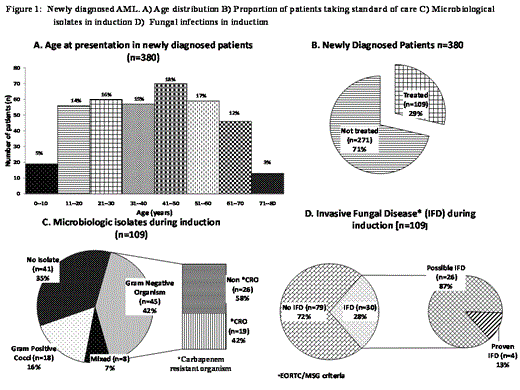Abstract
Management of acute myeloid leukemia (AML) in India remains a challenge. With a human development index rank of 134, a per capita gross net income of US$3500 and a government expenditure of only 1.2% of GDP allocated for health (http://indiabudget.nic.in) a major constraint to treatment of AML remains the cost of therapy. In the majority (>80%), in the absence of a universal and comprehensive health insurance, most payments are out of pocket (Karan et al. Health Policy and Planning 2008).
We undertook a two year prospective study to evaluate the clinical characteristics and outcome of patients with a diagnosis of AML (AML-M3 excluded) referred to our tertiary care center. The study was conducted from July 2012 till June 2014 and was approved by the institutional ethics committee. In addition to standard of care diagnostic tests and therapy a detailed questionnaire was administered to patients at diagnosis and on follow up. A total of 427 patients were diagnosed with AML during this period. Of these 380 (89%) were newly diagnosed. Of the newly diagnosed 47 (12.3%) were ≤ 15 years and 62 (16.3%) were ≥ 60 years old. The age distribution of newly diagnosed cases is illustrated in Figure 1A. The median age of newly diagnosed patients was 40 years (range: 1-79) and there were 244 (64.2%) males. The median duration of symptoms prior to first presentation at our hospital was 4 weeks (range: 1-52). ECOG performance score at presentation was ≤ 2 in 94.7%. Cytogenetic data was available in 281 and of these 33 (11.7%), 197 (70.1%) and 51 (18.2%) were in the good, intermediate and adverse risk groups respectively. FLT3 and NPM1 mutation status was available in 143 and of these 22 (15.8%) and 5 (3.4%) were FLT3-/NPM+ and FLT3+/NPM- respectively. The median distance from home to hospital was 580km (range: 6-3200) and 27 patients were from another country. 348 (91.6%) patients were self paying with all expenses being out of pocket (data was not available in 7).
Of the newly diagnosed patients only 109 (28.7%) opted for standard of care and were admitted for induction chemotherapy (Figure 1B). The comparison of the 109 that took treatment and the 271 (71.3%) that did not revealed that these two groups were comparable for the above baseline characteristics with the following exceptions; those that did not take treatment resided significantly further away from the hospital, had significantly longer duration of symptoms prior to reaching our hospital and were significantly less likely to be ≤15 years. Of the 271 that did not take treatment the major reason was lack of financial support in 219 (80.8%), lack of social support in 46 (17.6%) and a combination of denial, choice of alternative medicines, apathy and fatalistic attitude in 39 (14.9%). 220 (81%) of those that did not receive treatment were ≤ 60 years old.
Induction chemotherapy consisted of standard induction as in the BFM98 protocol for patients ≤15 years, conventional 7/3 in adults and hypomethylating agents in older patients or in young adults with significant co morbidities at the discretion of the treating physician (n=12(11%) and of these 6 were ≥60 years). Following induction chemotherapy 100% developed febrile neutropenia. Blood cultures detected an organism in 71 (65%) on at least one occasion and the organism was a Gram negative bacilli (GNB) in 45 (42%), Gram positive in 18 (16%) and mixed/ alternate infection in 8 (7%). Of the GNB 19 (42%) were carbapenem resistance organisms (CRO) (Figure 1C). 30 (27.5%) had a fungal infection in induction which was proven (EORTC/MSG criteria) in 4 (Figure 1D). There were 27 (24.7%) inductions deaths and of these 18 (67%) were due to sepsis related to GNB of which in 12(67%) the organism was a CRO. Among the patients that had an induction death in 12 (52%) there was evidence of a fungal infection which was proven in one case. The overall survival at one year was 70.4%±10.7%, 55.6%±6.8% and 42.4%±15.6% in patients ≤ 15 years, >15to <60 years and in ≥ 60 years age groups respectively.
In conclusion there are significant challenges in the management of AML in India. The major reason for not proceeding with treatment is the absence of financial resources. Induction deaths are related to a high incidence of multi-drug resistant organisms and fungal infections. The biggest constraint is the cost of the treatment and the absence of a health security net to treat all patients with this diagnosis.
Srivastava:Octapharma: Consultancy, Other.
Author notes
Asterisk with author names denotes non-ASH members.


This feature is available to Subscribers Only
Sign In or Create an Account Close Modal